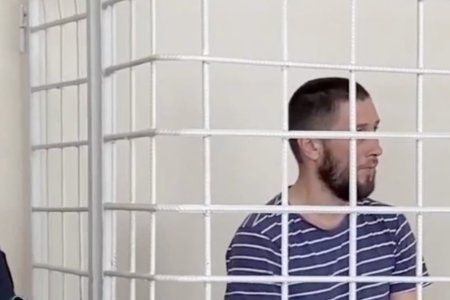
A Russian-controlled ‘court’ in occupied Sevastopol has massively increased the sentence passed in 2024 against Ksenia Svietlishyna. Although it is likely that the 39-year-old activist of the ‘Yellow Ribbon’ resistance movement was only ever prosecuted for pro-Ukrainian graffiti, she was now accused and, predictably, convicted of ‘state treason’, under Article 275 of Russia’s criminal code, as well as of vandalism (Article 214). She was sentenced to 13 years and 3 months’ imprisonment, followed by 18 months’ restricted liberty. by ‘judge’ Danil Sergeevich Zemliukov from the same occupation ‘Sevastopol municipal court’ that had, on 3 September 2024, sentenced her to 5 years and 3 months’ imprisonment.
Zemliukov had understood what was required of him following a fateful ruling by a cassation chamber of Russia’s supreme court on 8 July 2025. This overturned the original five-year sentence against Svietlishyna, requalifying one of the charges from the less serious Article 275.1 of Russia’s criminal code (cooperation on a confidential basis with a foreign state, international or foreign organization) to Article 275 (‘state treason’). The case was sent back to the same occupation ‘Sevastopol municipal court’ for ‘re-trial’ with this, in essence, a euphemistic way of demanding a larger sentence. The cassation hearing was held behind closed doors and was therefore only reported on 21 July when Crimean Process received unofficial information. According to their two sources, the cassation appeal had been heard by a panel of judges, including the former head of the Russian council of judges, Aleksandr Chervotkin.
Ksenia Svietlishyna (b. 28,04,1986) has been in custody since December 2023. During the original ‘trial’, she was charged over pro-Ukrainian graffiti, with this treated as vandalism motivated by political; ideological; racial; national or religious hatred or enmity; or motivated by hatred or enmity towards a social group’ (Article 214 § 2). She was supposed to have used a marker pen to write messages “expressing animosity to the Russian Federation” on street benches and other public objects. Judging by the messages which activists from the Yellow Ribbon movement normally leave, it is quite likely that the graffiti in question simply affirmed that Crimea is Ukraine and, at most, correctly identified Russia as an occupying state.
It was also claimed that, from April to November 2023, Svietlishyna had gathered information about the movements of military ships and aviation, as well as about places of deployment of Russian armed forces in Sevastopol and had passed these to “a representative of Ukraine via Messenger”. It is worth noting that there are strong grounds for scepticism about this charge which is largely copy-pasted from one Russian political ‘trial’ to the next. This only makes the cassation ruling so shocking. During the first ‘trial’, such alleged activities were qualified as ‘cooperation on a confidential basis with a foreign state, international or foreign organization’, and then changed, on 8 July 2025, into ‘state treason’ under Article 275.
The first sentence, on 3 September 2024, was passed by ‘judge’ Igor Vladimirovich Kozhevnikov. He imposed a 5-year 3 month term of imprisonment, to be followed by a year’s ‘restricted liberty’.
Like very many other political verdicts, this coincided with the posting of Svietlishyna’s videoed ‘confession and apology’ on notorious collaborator Aleksandr Talipov’s Crimean SMERSH Telegram page. Talipov and his Crimean SMERSH vigilantes, who hunt down people with a pro-Ukrainian position and force them to ‘repent’ on video. Although they are claimed to be a civic organization, Talipov and Crimean SMERSH work in close collaboration with the occupation enforcement bodies, meaning that, even where physical force is not applied to force out such ‘confessions’, the victims can be threatened with serious criminal charges and huge sentences if they refuse to ‘repent’..
It is clear from the video Talipov posted that Svietlishyna was admitting solely to having left pro-Ukrainian graffiti. Talipov essentially acknowledges that the Ukrainian was hounded by them for supporting Ukraine, but claims that, later, while searching her phone, the ‘enforcement bodies’ found, what he asserts to be, “correspondence with the SBU” [Ukraine’s Security Service]. That there was obvious communication with the SBU or other bodies seems unlikely given the initial and lesser charge under Article 205.1 (‘cooperation on a confidential basis with a foreign state, international or foreign organization’(. It is also telling that the reports about the sentence passed on 30 October claim that Svietlishyna as working for Ukraine’s Military Intelligence, not SBU. Had there been any real evidence of anything but pro-Ukrainian graffiti, it is inconceivable that the Russian ‘investigators’ would not have laid ‘treason’ charges against Svietlishyna immediately.
It is also telling that the earlier sentence against Svietlishyna was almost the same as that passed against Mykola Onuk for Yellow Ribbon activism in occupied Crimea.



